A Mostly All Boys Club
Coretta Scott King Illustrator Award by the numbers
by Christine Taylor-Butler
(Photo by Beth Tate)
Starting March 1st, we’re celebrating Women’s History month with 31 days of posts focused on improving the climate for social and gender equality in the children’s and teens’ industry. Join in the conversation here or Twitter #kidlitwomen and access all the #KidlitWomen posts this month on our FaceBook page https://www.facebook.com/kidlitwomen/
Martin Luther King had a dream.
But I’m not sure the awards committee saw the memo.
By now you’ve probably seen my previous blog entry on the low numbers for women in the Caldecott Awards (Illustration). The Coretta Scott King Award is much newer and was considered a blessing for African American content creators who struggled to gain the attention of major awards committees sponsored by ALSC within the American Library Association (ALA). But for African American women, the dream is deferred.
(I want to note that this is not a commentary on the merits or talent of the winners.)
Awards send a loud and clear message to publishers about what types of books a committee values and what content creators are worthy of attention. Publishing gets what it measures. So does the CSK award. The results may be linked by cause and effect.
The Coretta Scott King Illustrators Award:
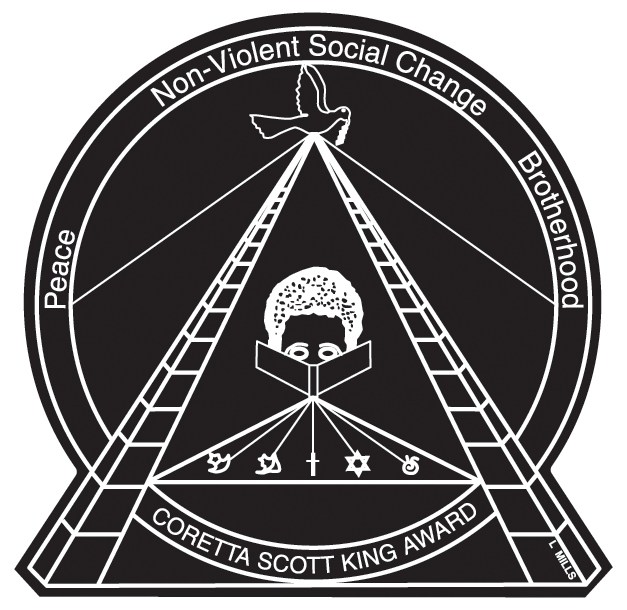
Established in 1970, the Coretta Scott King Book Awards are given annually to outstanding African American authors and illustrators of books for children and young adults that demonstrate an appreciation of African American culture and universal human values. The award commemorates the life and work of Dr. Martin Luther King, Jr., and honors his wife, Mrs. Coretta Scott King, for her courage and determination to continue the work for peace and world brotherhood.
The Award is given to an African American author and illustrator for outstanding inspirational and educational contributions. The Coretta Scott King Book Award titles promote understanding and appreciation of the culture of all peoples and their contribution to the realization of the American dream of a pluralistic society.
But in the Illustrator category – an award named for a woman seems to honor mostly men.
THE ILLUSTRATION WINNERS by percentage.
32 medals for men (78%)
8 medals for women (20%)
1 medal for illustrator pair (husband and wife duo) (2%)
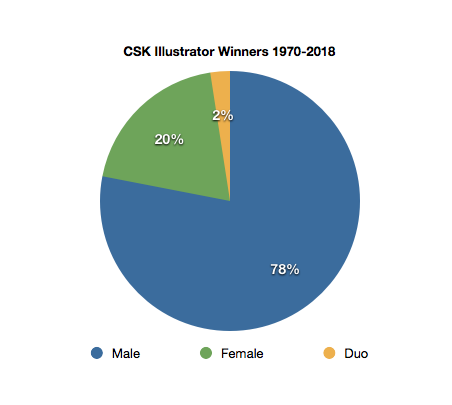
The Coretta Scott King Committee chose male illustrators 78% of the time compared to Caldecott’s 67%, thus rewarding publishers for their equally abysmal failure to find value in hiring and/or promoting women of color as illustrators.
The landscape is just as bleak for African American honor books.
THE CSK HONOR WINNERS by percentage.
55 Medals for men (80%)
9 Medals for women (13%)
5 medals for an illustrator pair (7%)
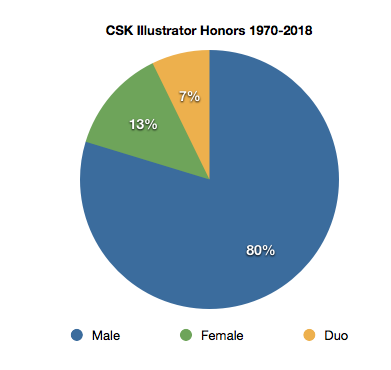
APPALLED? It gets worse
In the forty-five (45) years since the first illustrator award was named there have been 21 years in which men were named for all awards but not a single woman (including husband/wife pairs). That includes nine (9) of the last ten (10) years. In 2018 a woman was named winner, but all honors were awarded to men.
To look at the historical spread below, I started the clock at 1974 when the first illustrator award was given. However, from 1975-1977 there was no award given. This anomaly occurred again in 1985. No winner, no honor given. (The gaps in the chart below) Including those gaps – out of 45 years there were 36 in which no woman received the top award (medal) and 25 in which women received NO award at all.
There were several years when no honor award was granted and only a single illustrator medal was granted. To understand how bleak the climate is for African American women remember, no woman of color has ever won a Caldecott medal. So a Coretta Scott King award is an African American woman’s only remaining chance at recognition.
I separated out the CSK illustrator award into winner versus honor and lined up the years so you can see how it stacks up. In the last few decades, in the rare instance a woman was named winner (red), men took all the honor awards (blue spikes). You have to go back to the early 1990’s before a woman was named an honor in the same year as a woman was named a winner. (Diagram shows Honors on top chart, Winners on the bottom chart.)

EVEN WORSE: No Room At The Table?
The numbers are worse than they appear. That’s because the committee awarded medals and honors to the same illustrators over and over again.
- Not counting the husband and wife pairing (1 medal, 5 honors), there were 39 total individuals given awards of any kind (see chart below). Only ten (10) were women.
- Only 3 of the 10 women received more than one award.
- 11 men received more than one award, some in the same year or consecutive years.
- 7 men and 1 woman received 2 or more medals (dark purple)
- The top two men accounted for 11 of the 41 medals (25%) (dark purple)
- The top five men accounted for 20 of the 41 medals (nearly 50%)
- The same five men accounted for 19 of the 66 honor awards. (almost 30%)
- 9 people received only one medal and no honor awards (4 women and 5 men)
- 1 man received five honors and another received 2 but no medal
- 14 remaining people (3 women and 11 men) received a single honor award.
- NOTE: White illustrators are not normally eligible for a CSK award. However, there was one exception. A husband and wife team. As a result a white female has earned more CSK awards (6) than any female African American illustrator by virtue of being paired with an African American husband. The highest number of awards earned by an individual African American female illustrator is 4.
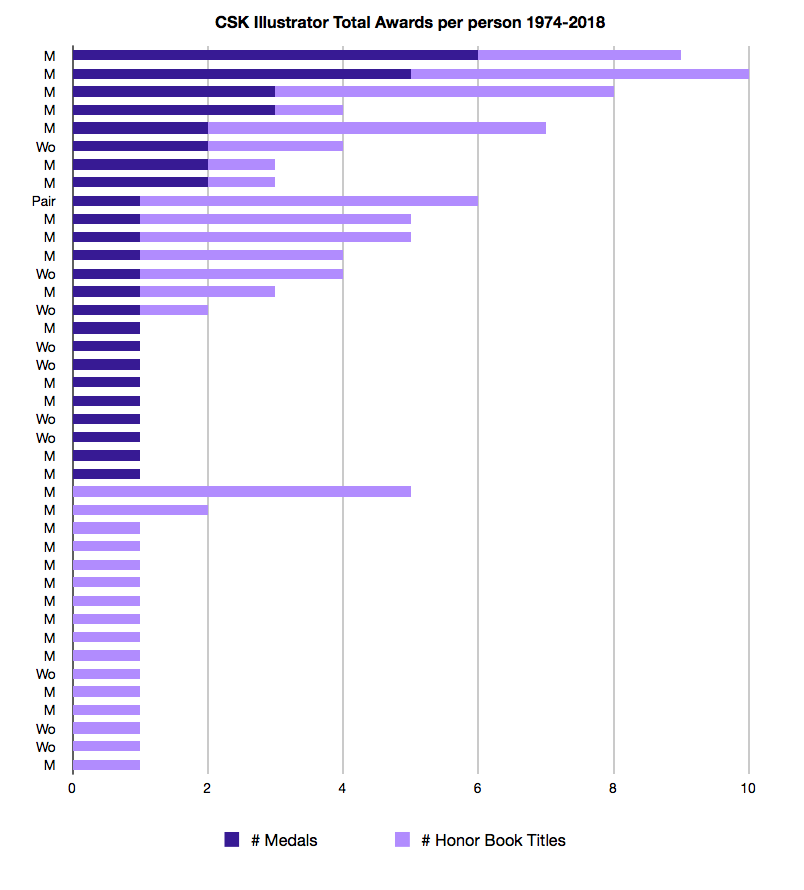
It’s an odd phenomenon since there are, in fact, other female illustrators with commercially published books to choose from in that time frame. I am told that even self-published books are eligible for consideration.
Looking at Caldecott (ALSC) the message was crystal clear. When evaluating illustrators of color for a medal, only a few will be chosen.
But not African American women.
And now it seems those same women are mostly shut out of the Coretta Scott King medal as well. This may translate into difficulty in obtaining contracts of substance at major publishers. Which then results in fewer books that can be considered. In an age of increasing diversity and female empowerment that’s a huge loss to the children we ultimately serve.
ONE ADDITIONAL NOTE (A digression):
To be fair, a 2013 analysis performed by Kyra Hicks revealed that women received the CSK Author award more often then men. However the numbers are not nearly as skewed (49% vs 44%). BUT when you add honor books for authors, the trend toward men winning the majority of all possible awards still holds true in the author category.
Hicks also noted that in six (6) of the years the John Steptoe New Talent award was available the committee failed to identify any African American (male or female) worthy of recognition for new talent.
ESSENTIAL QUESTION:
So I’ll paraphrase the questions I posed for the Caldecott Blog post:
Female African American illustrators across the country are producing beautiful artwork. So is this an issue of lack of visibility? Do publishers cherry pick who to boost based on trends? Are committees swayed by marketing and favor those with “buzz?” Or is this a matter of not valuing the range of art female artists create in general? Or hiring them to illustrate books that might be awards contenders? Is there a built-in bias in our industry that favors men over women content creators?
And I’ll add another – does the industry tend to devalue the work and content created by people of color in general?
The math seems quite clear. It’s all of the above.
You can find out more about the Women’s month initiative on gender inequality on Twitter at this link: #kidlitwomen or on Facebook at this link: #kidlitwomen

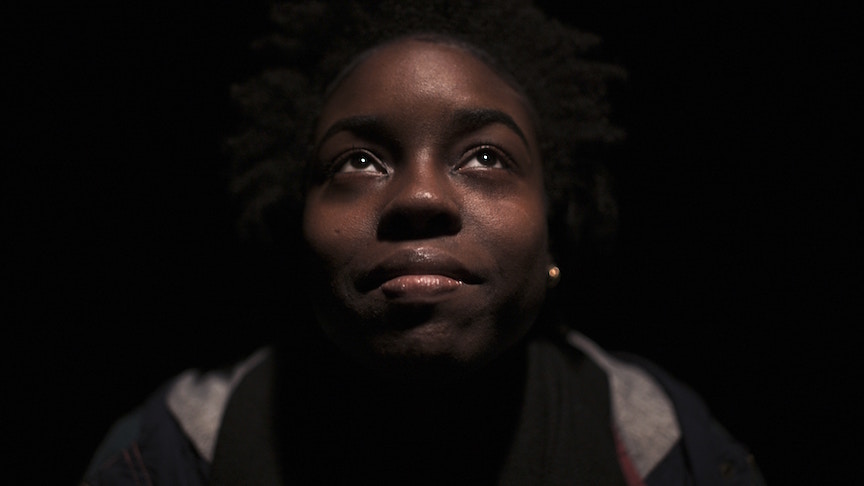
I wonder how many picture books illustrated by African American women were eligible in any given year?
Thank you for this analysis! I am a Black woman, artist, educator, and K-8 librarian moved by these statistics. I hope the children’s book industry and its stakeholders (educators, librarians, families, and children) create solutions together!